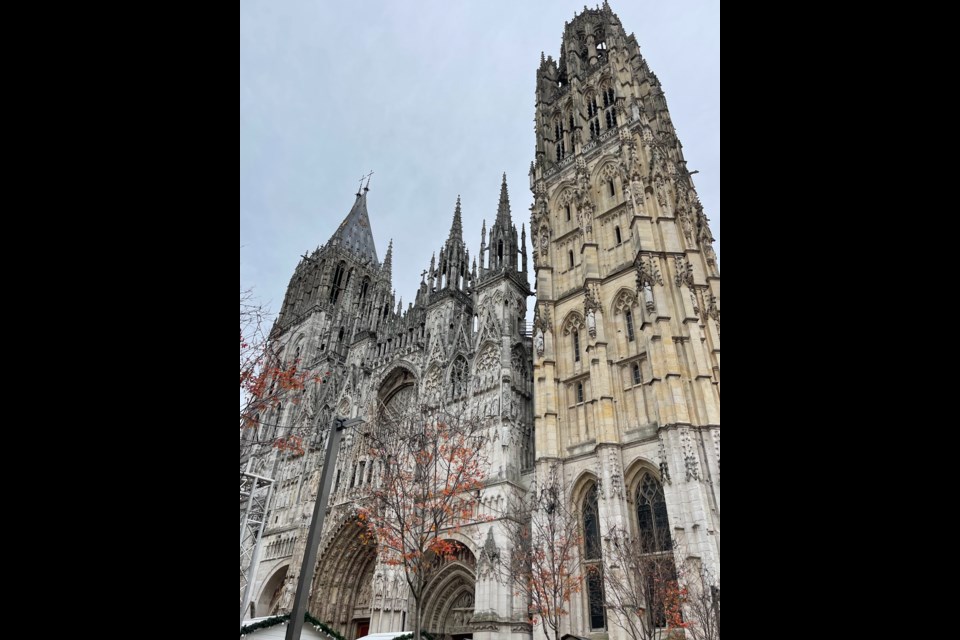Most people visit Normandy, France to head straight for its historic beaches that played a huge part in World War II.
But many miss out on other spots in Normandy, including the alluring town of Rouen, which is also full of its own history from many eras of time.
You can still see WWII bullet holes and shrapnel blemishes on Rouen buildings, and the city went through numerous conflicts including Viking raids, the Hundred Years War, the Franco Prussian War and the Wars of Religion during the Renaissance era. Plagues that destroyed Europe also happened in Rouen, too, and you can see a glimpse into the terror that plagues caused in the city as well.
Whether you stop in before or after your Normandy beaches visit, make sure to add Rouen to your list.
SEE
Eglise Sainte Jeanne d’Arc
As a patron saint of France, Joan of Arc is remembered for leading the French army to victory at Orléans in 1429, and for her urgency on the coronation of Charles VII of France during the Hundred Years War. Before the Hundred Years War was over, she was burned at the stake in Rouen, and today, you can see the place it happened next to Eglise Saint Jeanne d’Arc, a modern church right next to the site.
Notre-Dame Cathedral
As the tallest cathedral in France, the Notre-Dame Cathedral is hard to miss when in Rouen, but it’s a must-see, as its Gothic, Flamboyant, and Renaissance architecture is an incredible site. Take a stroll through the interior if you can and marvel at its huge stained glass windows. Construction of the cathedral was ongoing for almost 400 years, and inside is the tomb that holds Richard the Lionheart’s heart. It’s been beloved for centuries, with numerous artists interpreting it onto their canvases, including Claude Monet, who painted it more than 30 times from a studio across the street.
Aitre St-Maclou
A strange but interesting stop in Rouen is Aitre St-Maclou, one of the last medieval ossuaries in Europe and the only one of its kind in France. Plagues decimated the population of Europe in the Middle Ages, including the population of Rouen, where more than half of the residents died. Because of the amount of people dying at once, there wasn’t enough room in cemeteries to bury everyone, so Aitre St-Maclou was opened in the city center as a mass burial ground. When a new plague started in Rouen in the early 1500s, the wooden ossuary was built around the original plague pit and used to store bones from those who perished in the previous plague. This created more space for burials, and the area was used for burials until the last plague in 1668. Today, Aitre St-Maclou is used for exhibitions and as a cafe, and all remains were removed and moved to a final resting place outside the city in the 18th century.
Gros-Horloge Clock
Between the Notre-Dame Cathedral and the market square where Joan of Arc was burned at the stake is a street called Rue du Gros-Horloge. It was named after Le Gros Horloge, a beautiful Renaissance-era clock made in the 1300s set above the street. Take a moment to pause (just be out of the way of passing pedestrians) and look at the design of the clock, as it's full of astrological nods including moon phases and the gods that symbolize each day of the week. Notice the sheep, which represent the importance of wool that helped the city thrive. You can go inside the clock, as it doubles as a museum.
DINE
La Couronne
As the oldest inn in France, La Couronne is a staple in Rouen as it’s been open since 1345. It’s the place that inspired American cook Julia Child to teach the world how to cook, and it’s located near the site of where Joan of Arc was burned at the stake. The menu is extensive and includes seasonal dishes, a Taste of Normandy menu, holiday menus, and a Julia Child menu, which includes oysters, dover sole, green salad and cheese. Don’t miss the smoky snail stew with a chestnut emulsion, and Normandy beef with potatoes.
Dame Cakes
For a very Instagrammable breakfast, lunch, afternoon tea, or pastry break, stop into Dame Cakes for a delicious and beautiful bite. Tarts, cakes and cookies line the glass cases, and salads add to the lunchtime menu for a light mid-day meal. Normandy cider and apple juice accompany a range of hot and cold teas, and the upstairs room offers Notre-Dame Cathedral views.
HOW TO GET THERE
Nonstop flights from Dallas Fort Worth International Airport take you to Paris, where you’ll hop on your river cruise ship with Viking Cruises for the Paris and the Heart of Normandy cruise down the Seine River. Rouen is a stop along the route, and Viking guides work with local tour groups to give travelers the best of the best along the Seine.




